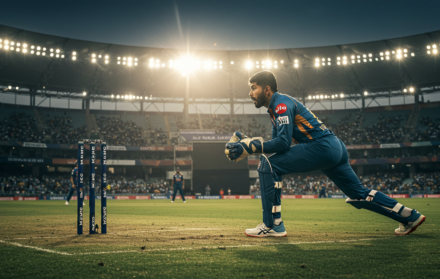
The Story of Sabina Park: Jamaica’s Cricket Gem
Nestled in the heart of Kingston, Sabina Park stands as a testament to Jamaica’s rich cricketing heritage. Established in 1895, this iconic ground has witnessed some of the most memorable moments in cricket history, from record-breaking innings to nail-biting finishes.
But beyond the statistics and scorecards, Sabina Park embodies the spirit and passion of Jamaican cricket.
From its early days as an urban residence known as a ‘Pen‘, Sabina Park has transformed into the epicenter of cricket in Jamaica. The ground’s name carries a poignant history, linked to a tragic event involving a slave named Sabina, who, in a desperate act of defiance, took the life of her child to prevent the child from enduring a life of servitude.
This act of rebellion and its aftermath are forever etched into the annals of Jamaican history, with the ground bearing her name in perpetuity.
But Sabina Park is more than just a cricket ground; it’s a symbol of national pride. As the home of the Kingston Cricket Club, it has played host to countless international matches, showcasing the talent and prowess of Jamaican cricketers on the global stage.
The picturesque backdrop of the Blue Mountains and Kingston Harbour adds to the ground’s allure, making it a favorite among players and spectators alike.
The significance of Sabina Park in the cricketing world cannot be overstated. It was here that England’s Andy Sandham scored the first-ever triple century in Test cricket.
The legendary Sir Garfield Sobers also etched his name into the record books at this very ground with his 365 not out, a record that stood unchallenged for over three decades. And who can forget Lawrence Rowe’s world record on debut with scores of 214 and 100 not out?
Yet, Sabina Park is not just about the past; it continues to evolve and adapt to the changing times. With the introduction of floodlights in 2014, the ground is now equipped to host day/night matches, ensuring that it remains at the forefront of international cricket.
Moreover, the mural featuring 19 famous Jamaican cricketers, constructed in 2021, serves as a reminder of the country’s rich cricketing legacy.
Historical Background: The Legacy of Sabina Park
Sabina Park, located in Kingston, is not just a cricket ground; it’s a symbol deeply rooted in Jamaica’s history. The origin of this iconic ground traces back to its days as an urban residence known as a ‘Pen’. Over time, it evolved into the cricketing heart of Jamaica, but the story behind its name is both poignant and powerful.
Sabina Park is named after a little-known slave woman who was buried there, having paid the ultimate price in her fight for freedom from the shackles of slavery.
The name ‘Sabina Park‘ is intrinsically linked to a tragic event involving a slave named Sabina. Operating from Goat Island, Sabina Park took a stand against the cruel system of European slavery that lasted for over three centuries in Jamaica.
The details surrounding her revolt are sparse, primarily due to attempts to suppress information about slave uprisings. However, what is known is that Sabina, in a desperate act, murdered her four-month-old child.
In her deposition at the Half-Way-Tree court, she admitted to the act, explaining that she did not want her child to endure a life of servitude. Sabina was owned by Joseph Gordon, the father of National Hero George William Gordon.
She was one of the 17 slaves on Goat Island, a property owned by Joseph Gordon, a Scottish planter who was granted vast lands in Jamaica by King Charles II.
Sabina’s act was a reflection of the inhumane conditions of slavery that drove many to take extreme measures in their fight against the system.
Her reasoning was profound; she believed that by reducing the number of hands available to work the plantation, the system of slavery would eventually collapse. Over time, Sabina Park’s actions were viewed by many enslaved women as an act of bravery.
They saw her as a leader who chose the painful path of sacrificing her own child rather than letting him be subjected to the horrors of slavery. For her act, Sabina Park was found guilty of murder and was hanged. She was laid to rest on the Liguanea Plains, at the very place that would forever bear her name – Sabina Park Pen.
The name endured because ordinary folks viewed her as a leader who employed an unconventional methodology to challenge the system of slavery.
In essence, Sabina Park is not just a testament to Jamaica’s cricketing legacy but also a reminder of the country’s tumultuous past and the sacrifices made by many in their quest for freedom.
Cricketing Milestones at Sabina Park
Sabina Park, with its rich tapestry of cricketing history, has been the stage for numerous iconic moments in the sport. Established as a Test cricket ground in 1930, it has since witnessed feats that have left indelible marks on the annals of cricket.
One of the earliest milestones at Sabina Park was during the ‘timeless‘ Test match between West Indies and England in April 1930. This match, which spanned from April 3 to April 12, saw the legendary George Headley, at just 19 years of age, score a second-innings 223.
This achievement positioned him as the youngest to score a double century until Javed Miandad surpassed it in 1976. However, England’s opener, Andy Sandham, left an even more significant mark during this match by scoring 325, the first-ever triple century in Test cricket.
Yet, of all the remarkable feats at Sabina Park, perhaps the most illustrious came in February 1958. A young Sir Garfield Sobers, at the age of 21, not only scored his first Test match hundred but went on to set a world record with a score of 365 not out.
This monumental achievement surpassed the previous record set by Sir Len Hutton of England and remained unbeaten for over 36 years.
Another unforgettable moment that etched its name in cricketing history was Lawrence Rowe’s world record on debut. Rowe showcased his exceptional talent with scores of 214 and 100 not out, setting a precedent for debutants in the world of cricket.
However, Sabina Park’s history is not without its challenges. The ground has seen its share of controversies, such as the Test match between West Indies and England in 1998, which was abandoned on its first morning due to a dangerous pitch. But these challenges have only added to the ground’s storied legacy.
Over the years, Sabina Park has undergone significant transformations in infrastructure. The Jamaican Government invested over US$30 million to revamp the stadium for the 2007 ICC Cricket World Cup.
Moreover, in 2014, lights were installed with assistance from the Indian Government, enabling the ground to host night matches and events like the vibrant twenty20 Caribbean Premier League.
Famous Matches and Moments at Sabina Park
Sabina Park, renowned for hosting famous matches and moments in the history of cricket, has witnessed several noteworthy events that have left a lasting impact. Let’s delve into some of these iconic occurrences at this Jamaican stadium:
In 1953, the Test match between the West Indies and England etched its name in history as Frank Worrell became the first West Indian player to achieve a remarkable triple century in Test cricket.
Fast forward to 1976, and Sabina Park bore witness to an exhilarating encounter between the West Indies and India. During this pulsating match, Michael Holding showcased his extraordinary talent by claiming an astonishing 14 wickets, including a sensational 8 for 92 in the second innings.
The year 1999 marked another memorable moment at Sabina Park when the West Indies went head-to-head with Australia in an epic contest. It was Brian Lara who stole the spotlight with his magnificent batting display, scoring an incredible 213 runs and playing a pivotal role in securing a crucial victory for the West Indies.
In 2007, the Cricket World Cup Final between Australia and Sri Lanka unfolded at Sabina Park, delivering a thrilling spectacle. The clash culminated in Australia emerging victorious, securing their third consecutive World Cup title.
Looking ahead, Sabina Park is destined to continue being the stage for unforgettable moments in cricket. Fans can eagerly anticipate witnessing remarkable performances and fierce battles between international teams. Sabina Park will undoubtedly provide cricketing spectacles that will captivate fans worldwide.
Challenges and Controversies: The 1998 Sabina Park Test Abandonment
Sabina Park, with its rich cricketing history, has not been without its share of controversies. One of the most notable incidents occurred in 1998 during a Test match between the West Indies and the touring England team. The match, which has since become infamous in cricketing circles, was abandoned after just 10.1 overs due to an unsafe pitch.
The pitch showed significant uneven bounce, making it perilous for the batsmen. England, having chosen to bat, quickly lost three wickets. Renowned cricket commentator Michael Holding remarked at the time,
“I’ve never seen a pitch as dangerous as that. The people responsible should be brought to task. This pitch isn’t fit for Test cricket or even club cricket for that matter. It’s completely substandard.”
However, former West Indies fast bowler Curtly Ambrose had a different perspective. He believed that the match officials acted hastily in abandoning the Test. Ambrose argued that the pitch, though uneven, could have been improved with more rolling.
He also pointed out that the presence of tall bowlers like himself and Courtney Walsh might have exaggerated the bounce. Ambrose’s sentiments were that the officials should have given the groundsman an opportunity to work on the pitch and then reassess its condition.
The pitch had been newly laid ahead of the Test, and its unpredictable nature was evident. Ambrose expressed surprise at England captain Michael Atherton‘s decision to bat first on such an unfamiliar surface.
He speculated that there might have been some gamesmanship involved, with the England team possibly exaggerating the pitch’s dangers after a poor start.
Ambrose’s comments shed light on the complexities of the situation. While the safety of the players is paramount, the decision to abandon a Test match, especially one with such high stakes, is never taken lightly.
The 1998 Sabina Park Test abandonment remains a significant event in cricket history, serving as a reminder of the challenges and controversies that can arise in the sport.
The incident also underscores the importance of pitch preparation and the significant role it plays in the outcome of a match. A pitch can dictate the flow of a game, influence strategies, and, in extreme cases like the 1998 Sabina Park Test, even determine whether a match can proceed.
In the annals of cricket, the 1998 Sabina Park Test will always be remembered not for the cricket played but for the controversy it sparked, the discussions it generated, and the lessons it imparted.
Facilities and Features: The Essence of Sabina Park
Sabina Park, the heart of cricket in Kingston, Jamaica, is not just a ground for sports but a blend of history, culture, and scenic beauty. The stadium’s architecture and surroundings make it a unique cricketing venue, offering both players and spectators an unparalleled experience.
The Members Pavilion, lying square of the wicket on the west side, is a testament to the rich legacy of the ground. It’s a place where members of the Kingston Cricket Club, which calls Sabina Park home, gather to watch matches, discuss the nuances of the game, and celebrate the sport’s traditions.
Facing the north is the George Headley Stand, named in honor of the legendary West Indian batsman. This stand offers a picturesque view of the Blue Mountains, a serene backdrop that contrasts beautifully with the intensity of the matches.
To the south, spectators once enjoyed a panoramic view of Kingston Harbour, though this vista is now partially obscured by the Northern Stand, a modern addition built for the 2007 Cricket World Cup.
In 2014, Sabina Park embraced modernity by commissioning floodlights, becoming the last international ground in the Caribbean to have this facility.
This significant upgrade allowed the ground to host day/night matches, enhancing the viewing experience for fans and proving especially beneficial for events like the Caribbean Premier League, where the Jamaica Tallawahs play their home games.
Another recent addition that celebrates Jamaica’s cricketing heritage is a mural constructed outside the ground in 2021. This artwork features 19 of Jamaica’s most iconic cricketers, paying tribute to the legends who have graced the sport and left an indelible mark on its history.
Sabina Park’s facilities extend beyond the stands. The Eastern Stands, for instance, have been transformed into a “Party Stand,” replacing the once-popular “Mound” stand. This change reflects the festive spirit of cricket in the Caribbean, where matches are as much about the sport as they are about the celebration.
Moreover, the ground boasts a massive five-level concrete stand, housing upscale private boxes, outside broadcast facilities, and amenities for the players.
Sabina Park is a blend of the old and the new, where cricketing traditions meet modern amenities. It’s a place where the past is celebrated, the present is lived, and the future is eagerly anticipated.
An Ode to Cricket: Why Sabina Park Matters
In penning this article, our intention was not merely to chronicle the history and features of Sabina Park. Instead, we aimed to capture the essence of a cricketing sanctuary that has, for decades, been the heartbeat of Jamaican and international cricket. Sabina Park is not just a ground; it’s a repository of memories, dreams, and aspirations.
Why does this article matter? Because Sabina Park is more than just a venue. It’s a symbol of passion, resilience, and excellence. It’s where legends were born and where history was made.
In a world where modernity often overshadows tradition, Sabina Park stands as a testament to the timeless beauty of cricket and the indomitable spirit of the Jamaican people.
In wrapping up our journey through Sabina Park’s hallowed grounds, we come to realize that its legacy is not just in the records it has witnessed or the legends it has nurtured.
Its true significance lies in its ability to inspire future generations, to evoke a sense of pride and belonging, and to serve as a beacon of hope and excellence in the world of cricket.
Through the echoes of past triumphs and the promise of future glories, Sabina Park remains a cherished gem in the crown of international cricket.





